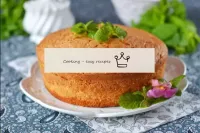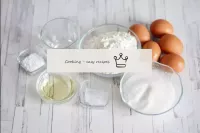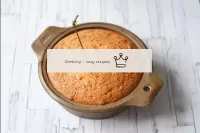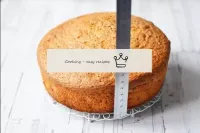Biscuit on boiling water
 8 servings
8 servings1 hour 20 min
Wheat flour - 200 g, Sugar - 200 g, Vegetable oil - 3 tbsp, Water - 3 tbsp, Eggs - 5 pcs., Baking powder - 1 tsp, Vanillin - 0.25 tsp.
 How to make a biscuit on boiling water? Prepare the necessary ingredients. Take large selected and fresh eggs. If the eggs are small, take 1 more. Eggs should be at room temperature, so take them out of the fridge beforehand. Vanillin can be replaced with 1 tsp vanilla sugar and poured, along with regular sugar, into the eggs (step 1). Take flour of the highest grade with protein content not more than 10. 3 g.
How to make a biscuit on boiling water? Prepare the necessary ingredients. Take large selected and fresh eggs. If the eggs are small, take 1 more. Eggs should be at room temperature, so take them out of the fridge beforehand. Vanillin can be replaced with 1 tsp vanilla sugar and poured, along with regular sugar, into the eggs (step 1). Take flour of the highest grade with protein content not more than 10. 3 g.  In a bowl, break the eggs at room temperature. Start beating with a mixer at low speeds, gradually increasing the speed to maximum. Pour all the sugar in parts. Beat to a lush stable foam and illuminate the mass. The mixture should increase by 3-4 times. But it is important not to overload the eggs: the mass must be lush and with many small air bubbles. If you beat too long, to density, then your cake will not rise when baking.
In a bowl, break the eggs at room temperature. Start beating with a mixer at low speeds, gradually increasing the speed to maximum. Pour all the sugar in parts. Beat to a lush stable foam and illuminate the mass. The mixture should increase by 3-4 times. But it is important not to overload the eggs: the mass must be lush and with many small air bubbles. If you beat too long, to density, then your cake will not rise when baking.  Add the flour mixture to the beaten eggs in 2-3 steps, gently mixing the mass with a silicone spatula from top to bottom, trying to prevent the dough from settling and breaking all the flour lumps. I prefer to mix the dough with a mixer at the lowest speeds. It only takes a short time to mix so as not to overload the eggs. In addition, after stirring with a spatula, small flour lumps may remain in the dough, which are easy to miss.
Add the flour mixture to the beaten eggs in 2-3 steps, gently mixing the mass with a silicone spatula from top to bottom, trying to prevent the dough from settling and breaking all the flour lumps. I prefer to mix the dough with a mixer at the lowest speeds. It only takes a short time to mix so as not to overload the eggs. In addition, after stirring with a spatula, small flour lumps may remain in the dough, which are easy to miss.  Cover the bottom of a 20cm baking dish with parchment and brush with butter. Pour the dough into the tin. Bake the biscuit in the oven preheated to 170 ° C for about 40 minutes (determine the time by your oven). In no case do not open the door for the first 30 minutes, otherwise the biscuit will immediately settle. *
Cover the bottom of a 20cm baking dish with parchment and brush with butter. Pour the dough into the tin. Bake the biscuit in the oven preheated to 170 ° C for about 40 minutes (determine the time by your oven). In no case do not open the door for the first 30 minutes, otherwise the biscuit will immediately settle. * Check the readiness of the biscuit during baking with a skewer - it should come out dry. But only start checking towards the end of baking. And if crumbs stick to the skewer, then the root is not baked inside. If you see that your top is already browned and the dough is not yet ready, cover the shape with a double sheet of foil. The finished sponge can be left in a cooling oven for 10 minutes.
Check the readiness of the biscuit during baking with a skewer - it should come out dry. But only start checking towards the end of baking. And if crumbs stick to the skewer, then the root is not baked inside. If you see that your top is already browned and the dough is not yet ready, cover the shape with a double sheet of foil. The finished sponge can be left in a cooling oven for 10 minutes.  Depending on the size of the shape, the biscuit will vary in thickness. In the shape of 20 cm, it is 6-7 cm thick. This is the standard thickness of a sponge cake for 3 cakes. As it cools, it can settle quite a bit, but evenly, over the entire surface. This is normal if the biscuit does not fail in the center. In the section, it can be seen that the dough was baked evenly.
Depending on the size of the shape, the biscuit will vary in thickness. In the shape of 20 cm, it is 6-7 cm thick. This is the standard thickness of a sponge cake for 3 cakes. As it cools, it can settle quite a bit, but evenly, over the entire surface. This is normal if the biscuit does not fail in the center. In the section, it can be seen that the dough was baked evenly.  Español
Español Français
Français Português
Português Русский
Русский 简体中文
简体中文 繁體中文
繁體中文 日本語
日本語 한국어
한국어 العربية
العربية Türkçe
Türkçe Қазақ
Қазақ Deutsch
Deutsch Italiano
Italiano Українська
Українська
 Sift the flour with baking powder and vanillin into a separate bowl. It is important to sift through the flour to saturate it with oxygen. Then the pastry will turn out to be airy and will rise well when baking.
Sift the flour with baking powder and vanillin into a separate bowl. It is important to sift through the flour to saturate it with oxygen. Then the pastry will turn out to be airy and will rise well when baking.  Pour odorless vegetable oil and boiling water into the dough.
Pour odorless vegetable oil and boiling water into the dough.  Mix the dough quickly and thoroughly, getting to the bottom, because all the liquid flows quickly to the bottom of the bowl. As a result of mixing, the mass should not lose its pomp, but acquire elasticity and maintain small bubbles on the surface.
Mix the dough quickly and thoroughly, getting to the bottom, because all the liquid flows quickly to the bottom of the bowl. As a result of mixing, the mass should not lose its pomp, but acquire elasticity and maintain small bubbles on the surface.  To prevent the sponge from falling off, turn it onto a rack and cool to room temperature.
To prevent the sponge from falling off, turn it onto a rack and cool to room temperature. 